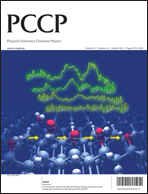Realization of color hue tuning via efficient Tb3+–Mn2+ energy transfer in Sr3Tb(PO4)3:Mn2+, a potential near-UV excited phosphor for white LEDs†
Abstract
A n-UV convertible phosphor Sr3Tb(PO4)3:Mn2+ with tunable-emitting color has been synthesized by solid state reaction. The GSAS refinement shows that the obtained powder crystallizes as a cubic unit cell with space group I![[4 with combining macron]](https://www.rsc.org/images/entities/char_0034_0304.gif) 3d, and Mn2+ ions occupy the Sr2+ crystallographic sites. Under 7F6 → 5D3 of Tb3+ excitation at 381 nm, Sr3Tb(PO4)3:Mn2+ not only exhibits 5D4 → 7F6–3 of Tb3+ green emission lines but also 4T1 → 6A1 of the Mn2+ orange emission band. In addition, the intensity ratio of the orange/green emission bands can be enhanced through the increase of Mn2+ content. The intense orange emission band of the Mn2+ ions is attributed to the efficient energy transfer from the Tb3+ to Mn2+ ions, which has been justified through the luminescence spectra and fluorescence decay dynamics. The energy transfer mechanism was demonstrated to be the electric dipole–dipole interaction based on the Inokuti–Hirayama theoretical model, and the energy transfer efficiency was calculated. Optimal-composition samples show high external quantum efficiency, up to 59.3%, indicating the potential of the powder as a n-UV convertible phosphor for white LEDs.
3d, and Mn2+ ions occupy the Sr2+ crystallographic sites. Under 7F6 → 5D3 of Tb3+ excitation at 381 nm, Sr3Tb(PO4)3:Mn2+ not only exhibits 5D4 → 7F6–3 of Tb3+ green emission lines but also 4T1 → 6A1 of the Mn2+ orange emission band. In addition, the intensity ratio of the orange/green emission bands can be enhanced through the increase of Mn2+ content. The intense orange emission band of the Mn2+ ions is attributed to the efficient energy transfer from the Tb3+ to Mn2+ ions, which has been justified through the luminescence spectra and fluorescence decay dynamics. The energy transfer mechanism was demonstrated to be the electric dipole–dipole interaction based on the Inokuti–Hirayama theoretical model, and the energy transfer efficiency was calculated. Optimal-composition samples show high external quantum efficiency, up to 59.3%, indicating the potential of the powder as a n-UV convertible phosphor for white LEDs.


 Please wait while we load your content...
Please wait while we load your content...